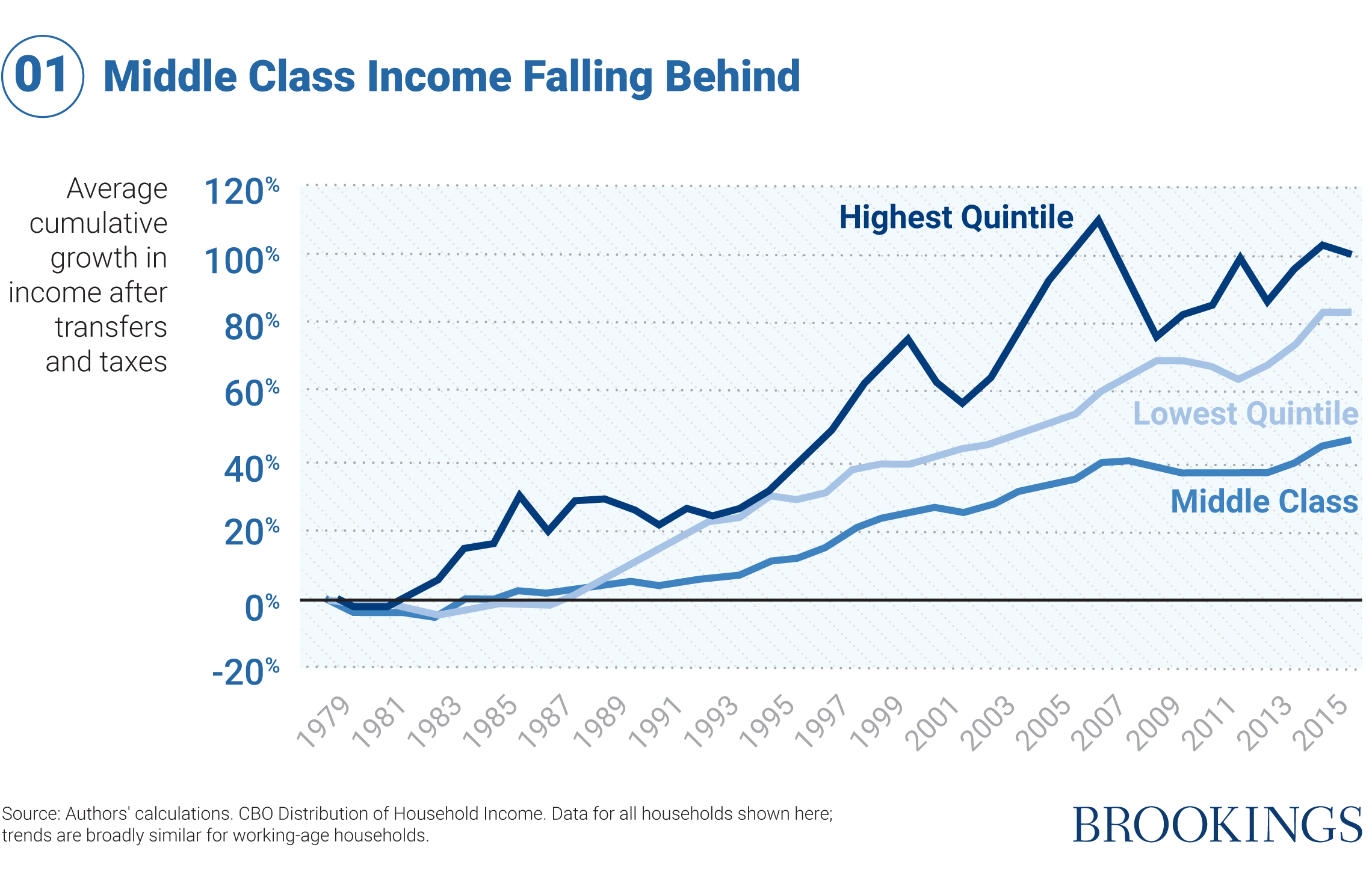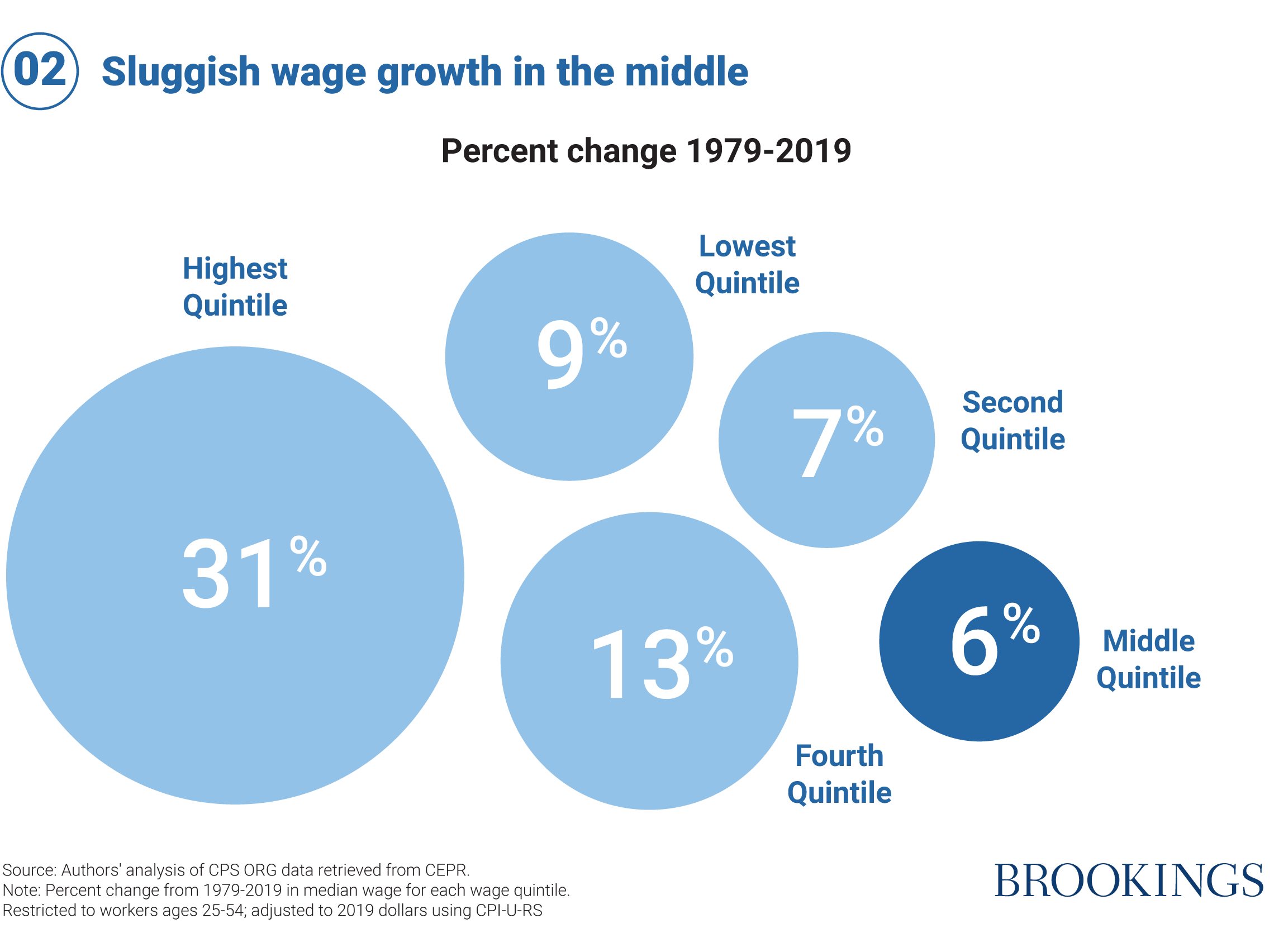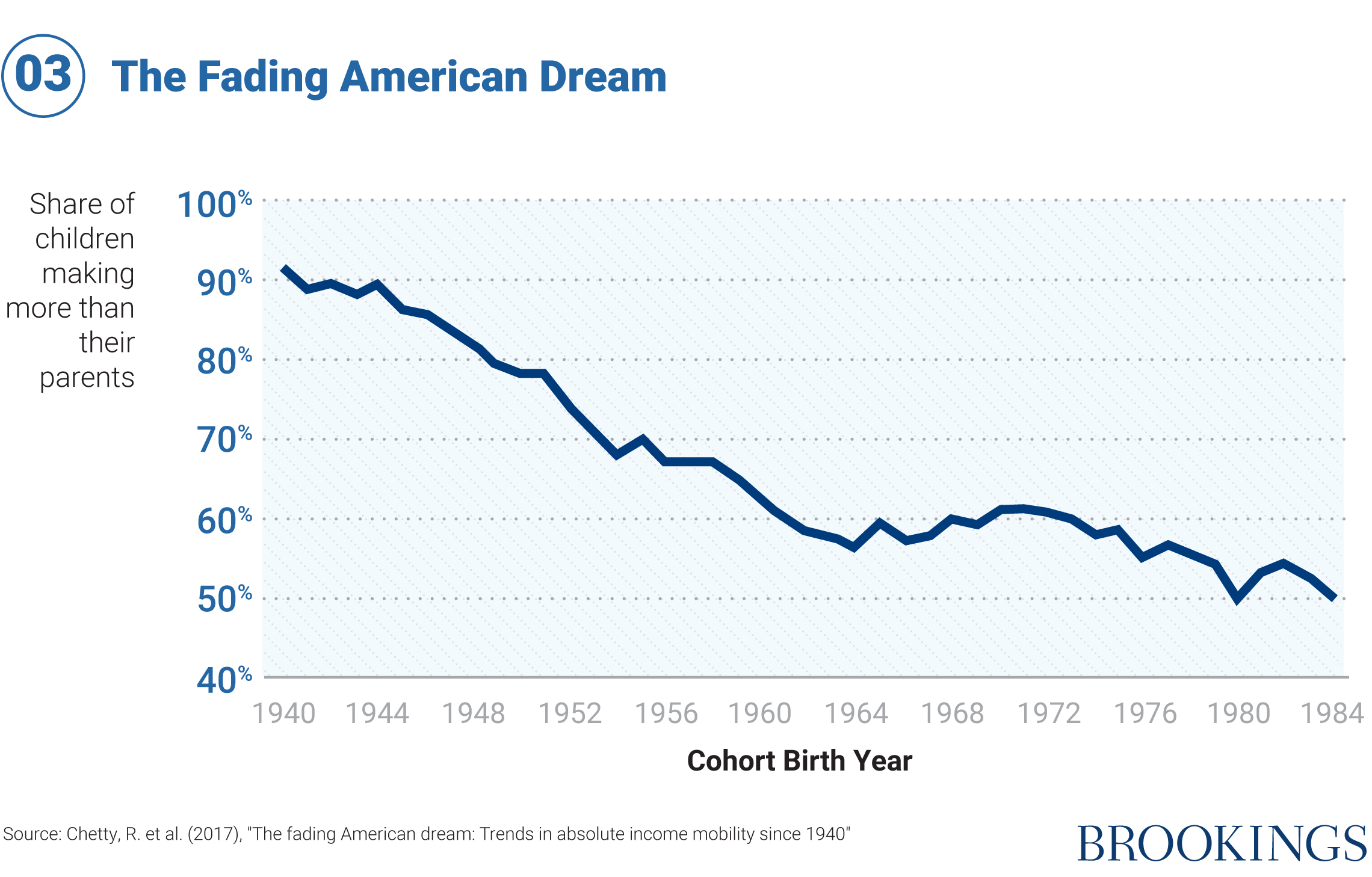
MONEY
Money matters. It can’t buy you love, but it can buy you food and shelter and clothes and entertainment and health care. Quality of life is not simply a product of quantity of money; but it is foolish to deny there is a connection.
A strong middle class, then, is one that is prospering economically. As nations grow richer, those riches should be broadly shared. This is the financial clause of the contract with the middle class. It is not being honored. American middle-class families both need — and deserve — more money.

Middle class falling behind
The middle class has experienced much slower income growth than both the affluent (who have seen rising wages) and the poor (who have been helped by an expanded safety net). The household incomes in the middle 60 percent of the distribution have grown only about half as fast as those in the bottom and top 20 percent, once taxes and transfers are taken into account (Figure 1).

When money is tight, it is harder to build wealth. The median middle-class family has $4,000 in liquid wealth and $87,000 of total wealth, compared to $31,000 and $807,000 for top-quintile families. Wealth inequity is growing even faster than income.
So what has gone wrong? Why have middle-class incomes grown so slowly?
Slow wage growth
Wages are the main source of income for middle-class families – more so than for the affluent, who get some of their income from capital, or for the poor, who receive a much higher share of their income from government transfers. But wage growth in the middle and bottom of the earnings distribution has been sluggish in recent decades (Figure 2).

Even as wages picked up among the poor and the well-off in the recovery from the Great Recession, growth rates were much lower for middle-class workers – and that was before COVID-19 cratered the economy. Importantly, the modest income growth of middle-class families is almost entirely due to the rise of working hours and especially the wages of women. This is one reason we argue so strongly, especially in the next chapter, that family policy and economic policy must now go hand in hand. And because the number of middle-class families that can add another earner is now decreasing, this route to higher income is closing fast.
The brute fact is that the transmission mechanism between economic growth and wage growth is breaking down. For decades, the U.S. labor market has failed to deliver enough money to middle-class households. Why? Why, for so many middle-class Americans has “economic growth become a spectator sport?” as the economist Jared Bernstein memorably put it.
The one-word answer from economists used to be “productivity.” The more workers can produce, the more they’ll get paid. Getting higher wages, then, means raising productivity by increasing skills. This is all true as far as it goes. And it is a good reason to invest heavily in education, as we’ll argue below. But it doesn’t go far enough. The big story here is not just productivity. It is power.
As Michael Strain, director of economic policy studies at the American Enterprise Institute, writes, “it is most useful to think of wages as being determined by a combination of competitive market forces, bargaining power, and institutions.” That is right, but we haven’t focused enough on the power side of the equation. Economic power has become more concentrated and worker power has diminished. Workers are getting a smaller share of economic output, down to 58 percent from 66 percent in 1960. Just one-in-20 workers in the U.S. private sector are members of a union, down from its high of over one third in the 1950s.
Many other factors are also impacting power, wages, and work, including automation, especially AI; trade flows, particularly from China; greater concentration of economic activity in fewer firms; and the geographical clustering of good jobs in certain urban areas, combined with declining worker mobility. But the shift in the power dynamics in the economy, above all from labor to capital, is the main reason for the sluggish growth in the paychecks of middle-class workers.
Middle-class prosperity must be based primarily on rewarding work. Americans value work far more than people in many other countries. Work is, of course, a means to an end – more income. But it is more than that. It is also a source of identity, self-respect, connection to others and sense of purpose. It is also essential to a well-functioning society. The pandemic revealed how much we depend on the workers who produce our food, deliver packages, care for the elderly, and clean our schools, offices, and hospitals.
Less upward mobility
Part of the American contract is that each generation will rise on the shoulders of the one before. But this promise is not being fulfilled. Nine-in-ten Americans born in 1940 ended up richer than their parents; for those born in the 1980s, the number is 50 percent. About a third of the mobility drop can be explained by slower growth, but the rest is the result of rising inequality. People have noticed. Only about one-in-three U.S. citizens believe today’s children will be better off than their parents (and this was before COVID-19).

Mobility during the working years has dropped, too. The chances of a middle-class earner (in deciles four through seven of the distribution) moving up to the top fifth of the earnings ladder, over a 15-year period, has dropped by 20 percent since the early 1980s.
So: in recent decades, the American middle class has experienced slow income growth, near-stagnant wage increases, and declining odds of upward mobility. Inequality is not a feeling; it is a fact. To help repair the economic contract with the middle class, we propose two major reforms: eliminating income tax for most of the middle class and providing two years of free public college.
You got to put in more work to be able to take care of your family.
Father, Prince George’s County, MD
Cut income tax for middle class
Given the economic trends described above, the middle class deserves a tax cut. We propose eliminating income tax by raising the standard deduction for most middle-class families — specifically, any married couple making less than $100,000 a year or any single person making less than $50,000. This is an average tax cut of around $1,600 for middle-class families. It would also mean that for most Americans, “April 15 would be just another spring day,” as Columbia law professor, Michael Graetz puts it.
To be clear, this is not because we think taxes are a bad thing. Quite the opposite. Taxes are good. They provide the resources for public goods to help those most in need and to invest in the future. Income tax accounts for about half of federal revenue. But some taxes are better than others. The burden should be shared fairly, and beneficial behaviors rewarded. A tax on the highest income earners is appropriate because money is increasingly concentrated at the top. Taxing capital, consumption, and carbon is appropriate if the goals are to reward work, promote saving, and protect the environment. Drawing on the work of our Brookings colleagues, especially William Gale and Adele Morris, we propose new or higher taxes on:
- Capital. Capital is lightly taxed in the U.S. compared to earned income. This is backward. Instead of hitting work, we should aim to tax wealth. Unfortunately, direct wealth taxes are tough to administer; it is far simpler to eliminate step-up basis at death and expand the estate tax. These two measures would raise around $135 billion a year. We also favor raising the corporate tax to 25 percent, expensing investment (to encourage growth) and eliminating corporate interest deductions (to put debt and equity financing on a level playing field).
- Consumption. We support a value-added tax (VAT) of 10 percent, about half the average rate in other OECD nations. With a rebate, a VAT would be mildly progressive and still raise around $240 billion a year.
- Carbon. The U.S. response to the climate crisis was weak before 2016; since then, at least at the federal level, it has been nonexistent. The obvious policy move here is a carbon tax, which would marshal market incentives to environmental ends. A carbon tax starting at $25 a ton could raise around $110 billion a year and cut emissions to about a quarter below 2005 levels.
I’m hoping that now that my youngest is in first grade, I can start getting more work and have more financial stability.
Man, Lebanon, PA
We also propose eliminating many tax deductions — including those for mortgage interest and state and local taxes (SALT), which are highly regressive. They make the whole system unnecessarily complicated, too – and therefore onerous and time consuming for individuals. A much higher standard deduction would make most of these tax preferences moot for the middle class, who will almost always be better off taking the standard deduction; which makes the case for eliminating them entirely even stronger. The deduction for business pass-through income should also be eliminated. Not only is it highly regressive, but it creates opportunities for tax avoidance.
The tax proposals in this chapter are designed not simply to be self-financing (revenue neutral) but to provide sufficient additional revenue to pay for other items in this contract. While the deficit is too big, reducing it needs to wait until the economy is in much stronger shape.
In short, we are proposing that the U.S. tax code be reformed and re-founded on clear principles of fiscal prudence and fairness, with the goal of rewarding work and improving the environment, but also meeting the specific needs of the middle class. In addition, a new pro-work contract with the middle class should include the following:
- A $12 per hour federal minimum wage floor, but with higher rates in many areas
- Worker tax credits for the bottom half of wage earners, administered through an offset to their payroll taxes
- Tax incentives for corporations to train their workers and share profits broadly
- Labor law reform and workers’ councils to strengthen employee engagement and bargaining power
- Adequate fiscal and monetary stimulus to create and maintain full employment
Scholarships for service
The idea of making college free has an immediate appeal. Middle-class families know their children will need more than a high school education to flourish, but they worry about debt. Critics of free college proposals (including ourselves) point out that since students from affluent families attend the most expensive colleges, progressive-sounding free college proposals often turn out to be regressive in practice.
This argument could be made — and in fact was made, a century ago — against the idea of providing free high school. At some point, Americans decided that a high school education ought to be provided as a public good. In the first half of the 20th century, the average American could ascend to the middle class on a high school diploma alone, and our education system reflected this reality by making K-12 free. Another criticism is that completion is now a bigger concern than enrollment; this is true, but there are effective programs that provide the support students need to earn a degree or a certificate, which should be expanded.
In today’s economy, a high school diploma is not enough. Post-secondary education or training is now the gateway to the American Dream. We need a free public K-14 education system. But in the spirit of partnership that underpins this contract, free college or vocational training ought to be conditional on time in the military or civic volunteering: Scholarships for Service.
Specifically, we propose that anybody completing a year of full-time national service, either military or civilian, as described in Chapter 3, would be entitled to two years of tuition-free education at any public higher education institution in their home state, including technical and vocational colleges, or at a government-subsidized apprenticeship with an employer. We believe that national service and post-secondary learning should be the norm for every young American. By combining the responsibility to serve with the right to higher education, we hope to encourage both.
What would free college or training cost, under our scholarships-for-service plan? It would depend on how many people took up the offer, which colleges they then attended, how many years they attended, and in which states they attended. But for illustration, let’s assume that a third of young Americans perform a year of service and then complete two years of post-secondary training or education. The cost of the free college element would be around $20 billion a year — a much-needed investment in both the social capital of our nation, and the human capital of its future citizens.
Renewing the economic contract
It hardly needs saying that there are many other reforms that could put more money on the table of middle-class families. These include help with childcare costs (which we address in the next chapter), stronger retirement options, and affordable health insurance; although as we argue in Chapter 4, the focus needs to be more on health than on health care.
Much of our own work and that of our colleagues at Brookings has been on finding ways to improve the lives of all Americans, including those who are poor. Nothing in this document should be read as diminishing the importance of that task. But the economic position of the middle class, especially in such a rich nation as ours, is sufficiently troubling to require bold strokes, like those offered here, to help. A prosperous middle class provides the foundation stone for a strong society and a healthy democracy.
Special thanks to Chris Pulliam and Ariel Gelrud Shiro for their research support.

America can only be as strong as the American middle class. We believe that the new contract we have described here, based on the core principles of partnership, prevention, and pluralism, holds out the promise of a better future for the middle class — and therefore for the nation. Let us know what you think.


